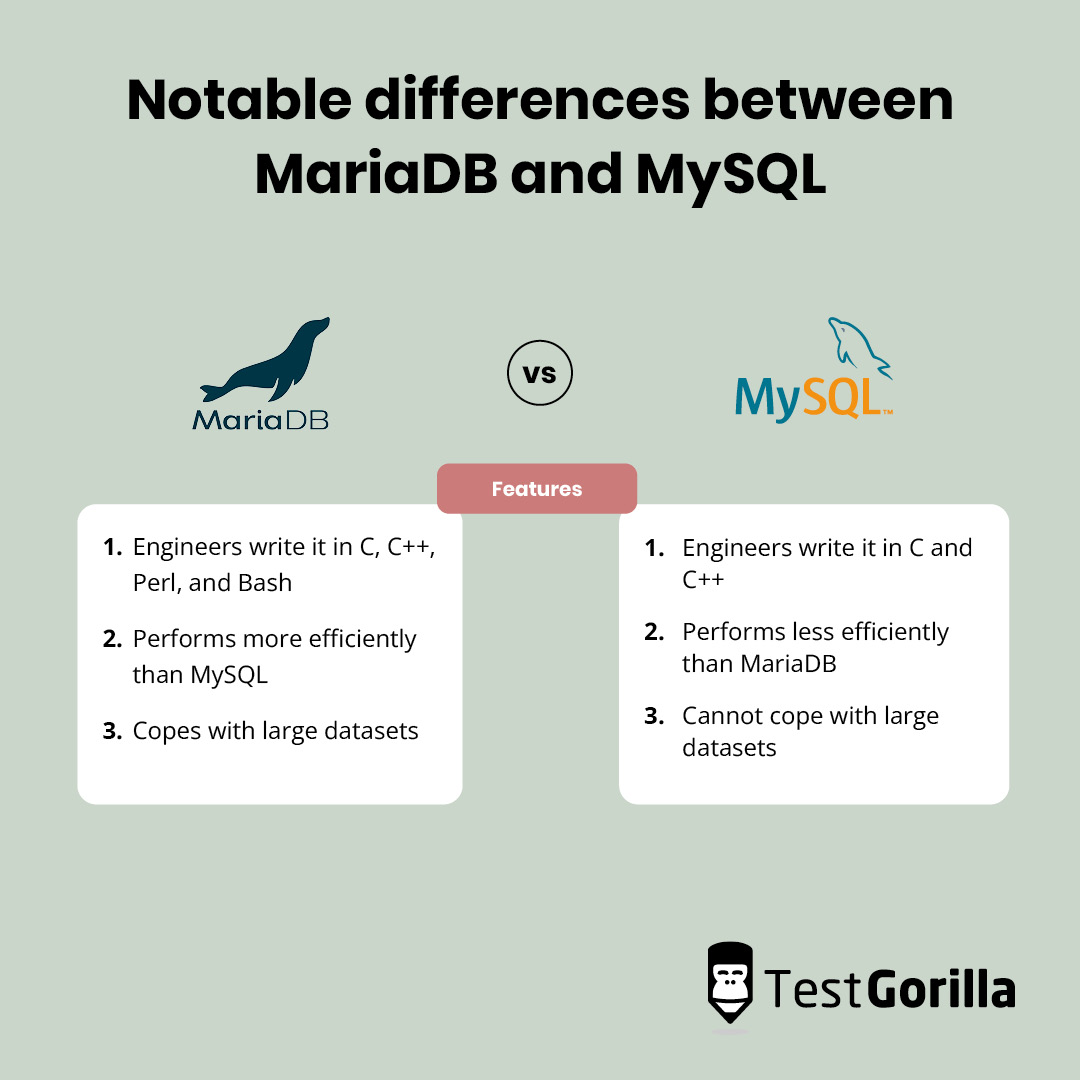If you’re a non-technical recruiter hiring a MariaDB engineer or training a new hire, you should consider two important things. Do your applicants know the similarities and differences between MariaDB and MySQL? And do they have the MariaDB skills to assist your team of engineers?
One of the fastest ways to answer these questions is with a MariaDB Developer skills test, which can help you (even if you’re a non-technical recruiter).
If you want to learn more about the differences between MariaDB and MySQL so you can assess your candidates’ skills more thoroughly, read this article. It focuses on these two well-known relational database-management systems (RDBMSs) and the factors that distinguish them from each other.
Table of contents
- How similar is MariaDB to MySQL?
- What are the main differences between MariaDB and MySQL?
- Is it possible for engineers to use the MariaDB database instead of MySQL?
- Which is more popular: MariaDB or MySQL?
- PostgreSQL vs. MariaDB: Which is more popular?
- PostgreSQL vs. MariaDB vs. MySQL: What are the main differences
- Which skills do engineers need when using MySQL?
- Which skills do engineers need for MariaDB?
- Do engineers use the same syntax for MariaDB and MySQL?
- Hire engineers who understand the difference between MariaDB and MySQL
How similar is MariaDB to MySQL?
Both MariaDB and MySQL are relational database-management systems. While MySQL has been available for over 20 years, MariaDB is considered a “fork” that Michael Widenius released in 2009. Widenius created both MariaDB and MySQL. However, there are several differences between the two RDBMSs.
What are the main differences between MariaDB and MySQL?
One of the critical differences between MariaDB and MySQL is that while software engineers write both MySQL and MariaDB in C and C++, they can also write MariaDB in Perl and Bash. It’s also true that MariaDB operates more efficiently than MySQL, supports binary encryption, and can cope with large datasets.
On the other hand, MySQL offers data masking options to your engineers, albeit without supporting binary logs or encryptions. Unlike MariaDB, this RDBMS cannot cope with large datasets.
Here’s a summary of the notable differences between MariaDB and MySQL:
MariaDB Features | MySQL Features |
Engineers write it in C, C++, Perl, and Bash | Engineers write it in C and C++ |
Performs more efficiently than MySQL | Performs less efficiently than MariaDB |
Copes with large datasets | Cannot cope with large datasets |
Is it possible for engineers to use the MariaDB database instead of MySQL?
Yes, your engineers can use the MariaDB database instead of MySQL. The latter is a drop-in replacement and uses the same structures as MySQL. Since the two RDBMSs are similar, the developers who created them do not need to upgrade MySQL.
Which is more popular: MariaDB or MySQL?
In terms of popularity, engineers generally prefer MariaDB over MySQL. On the RDBMS ranking tables for 2022, MySQL ranks second (after Oracle) while the MariaDB database ranked eighth.
Despite the difference in these rankings, some of the key reasons MariaDB is so popular is that it provides your engineers with popular programming language support (such as PHP) and 12 extra storage engines – including several high-performance ones. Engineers can integrate these storage engines with many other relational database management systems, and use them to elastically scale and distribute tables in a high availability environment.
PostgreSQL vs. MariaDB: Which is more popular?
Another popular relational database-management system that you’ll find on the ranking tables is PostgreSQL. PostgreSQL is not as popular as MySQL, ranking fourth. So, in terms of RDBMS popularity and after reviewing PostgreSQL vs. MariaDB and MySQL, MySQL is still the most popular.
When comparing all three RDBMSs, a few differences become clear.
PostgreSQL vs. MariaDB vs. MySQL: What are the main differences
While PostgreSQL supports JSON data types, MariaDB provides a LONGTEXT column, and MySQL supports various data types (including JSON). Nevertheless, both MariaDB and PostgreSQL use NoSQL databases to store unstructured data. In contrast, MySQL only supports structured data using a structured query language.
Engineers use different skills for each of these RDBMSs. To review your engineering candidates’ PostgreSQL skills, check out our PostgreSQL test, created by subject-matter experts.
Continue reading to discover which other skills tests you can use to assess MySQL and MariaDB skills.
Which skills do engineers need when using MySQL?
Knowledge of structured data and the structured query language SQL is vital for engineers who use MySQL. It’s also essential that your engineers understand how MySQL fits into the world of DevOps.
Should you need to assess your engineers’ SQL and DevOps knowledge, you can do so with an SQL skills test and a DevOps skills test.
Which skills do engineers need for MariaDB?
Knowledge of unstructured data and NoSQL databases is critical for engineers who use MariaDB. These skills will affect how efficiently they can manage data in the RDBMS. You can review your employees’ MariaDB skills using a MariaDB skills test.
Do engineers use the same syntax for MariaDB and MySQL?
Engineers use very similar syntax and coding standards for MariaDB and MySQL. There are just a few small syntax and coding differences between these two RDBMSs.
Engineers should know that case sensitivity applies to MariaDB but not to MySQL. They should also know that while MariaDB supports the INTERSECT and EXCEPT functions, MySQL doesn’t.
The final difference between MariaDB and MySQL is that MariaDB’s TRUNCT table function offers cascade options that are transaction safe. MySQL offers TRUNCT table functions, but they don’t support CASCADE options.
Here’s a quick summary of the syntax differences between MariaDB and MySQL:
MariaDB Syntax Functions | MySQL Syntax Functions |
MariaDB has case sensitivity | MySQL doesn’t have case sensitivity |
MariaDB supports INTERSECT and EXCEPT functions | MySQL doesn’t support INTERSECT and EXCEPT functions |
MariaDB offers TRUNCT tables that provide transaction-safe CASCADE options | MySQL offers TRUNCT tables that don’t support CASCADE options |
Hire engineers who understand the difference between MariaDB and MySQL
Hiring and training professional MariaDB engineers requires some assessment and skill reviews. However, once you know the main differences between MariaDB and MySQL, you’ll have no problem recruiting an expert with the right skills.
When you begin the hiring process, don’t forget to use a MariaDB (Dev) skills test to review your applicants’ knowledge as soon as they apply. This method will identify the candidates who can use MariaDB confidently.
With TestGorilla, you can evaluate your applicants objectively and without bias. Sign up today to hire engineers who understand the difference between MariaDB and MySQL and will help you complete your database-management projects successfully.
Related posts
Hire the best candidates with TestGorilla
Create pre-employment assessments in minutes to screen candidates, save time, and hire the best talent.
Latest posts
The best advice in pre-employment testing, in your inbox.
No spam. Unsubscribe at any time.

Hire the best. No bias. No stress.
Our screening tests identify the best candidates and make your hiring decisions faster, easier, and bias-free.
Free resources
This checklist covers key features you should look for when choosing a skills testing platform
This resource will help you develop an onboarding checklist for new hires.
How to assess your candidates' attention to detail.
Learn how to get human resources certified through HRCI or SHRM.
Learn how you can improve the level of talent at your company.
Learn how CapitalT reduced hiring bias with online skills assessments.
Learn how to make the resume process more efficient and more effective.
Improve your hiring strategy with these 7 critical recruitment metrics.
Learn how Sukhi decreased time spent reviewing resumes by 83%!
Hire more efficiently with these hacks that 99% of recruiters aren't using.
Make a business case for diversity and inclusion initiatives with this data.




















